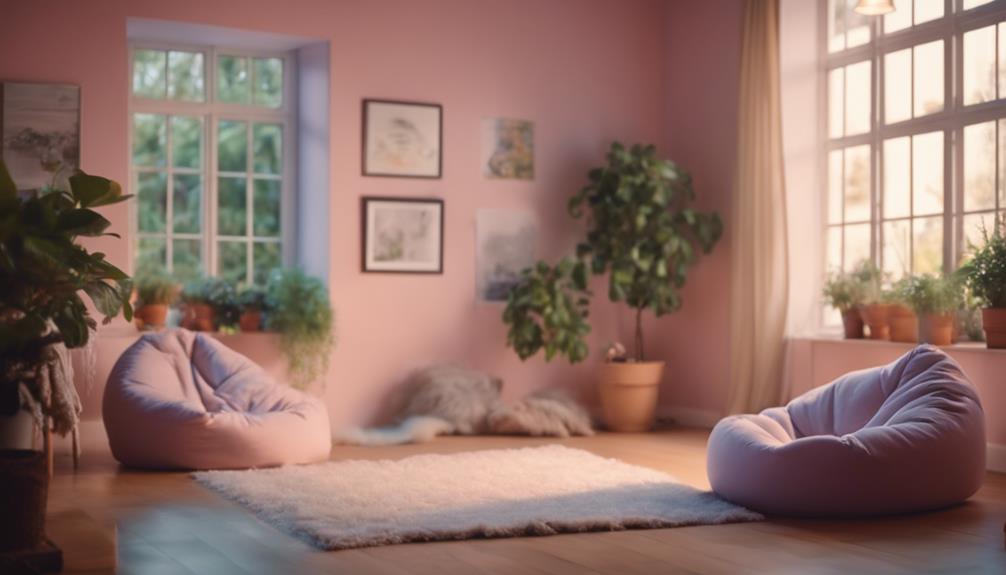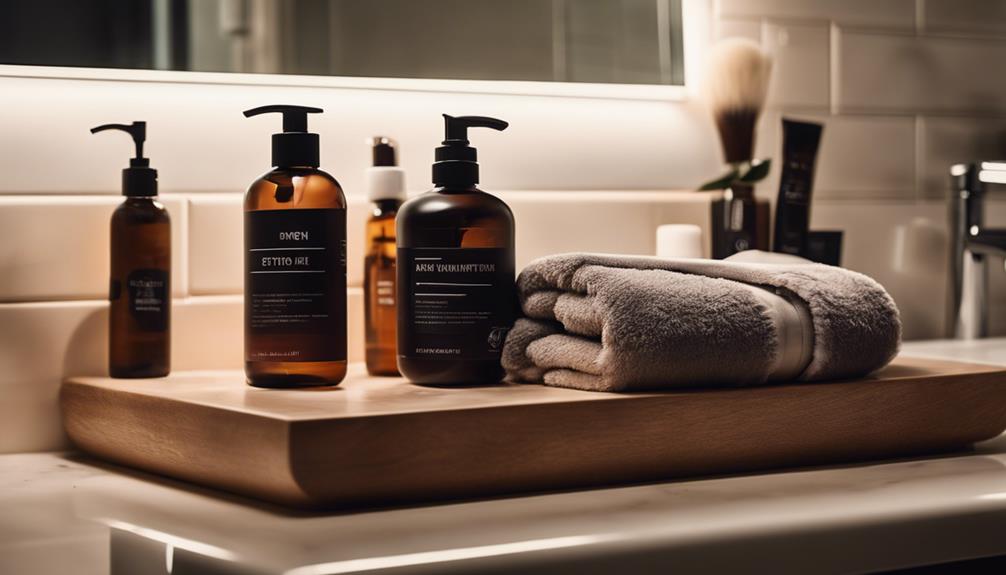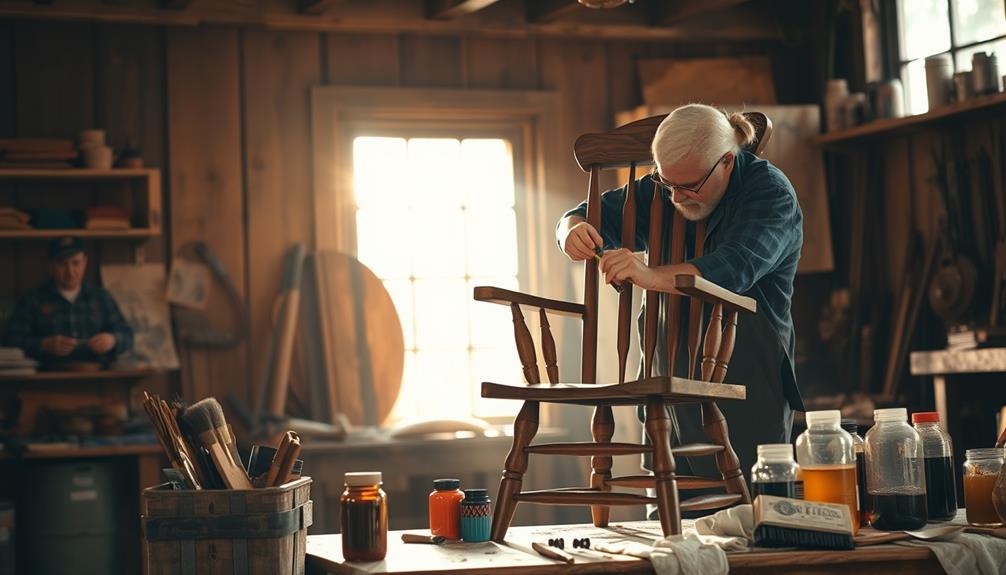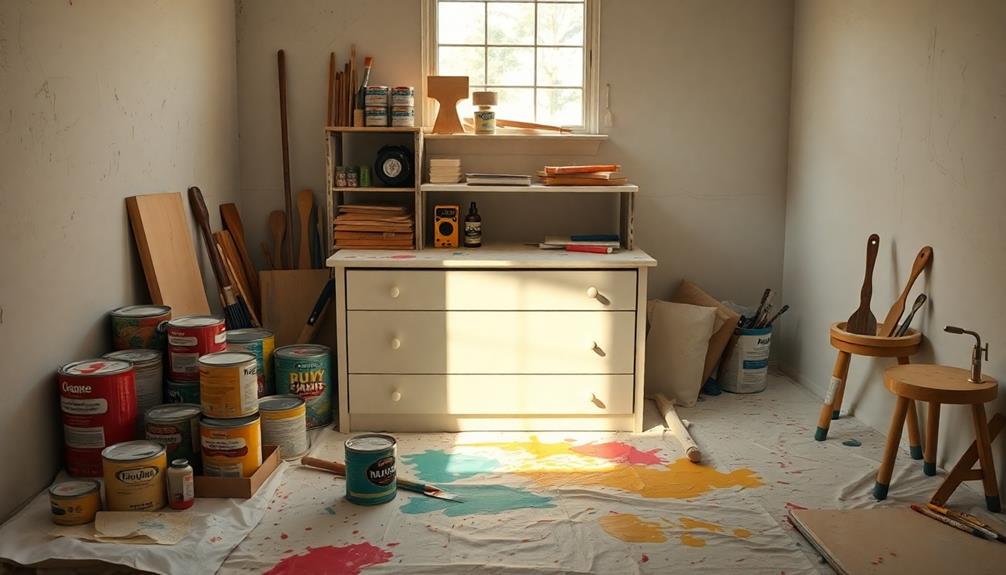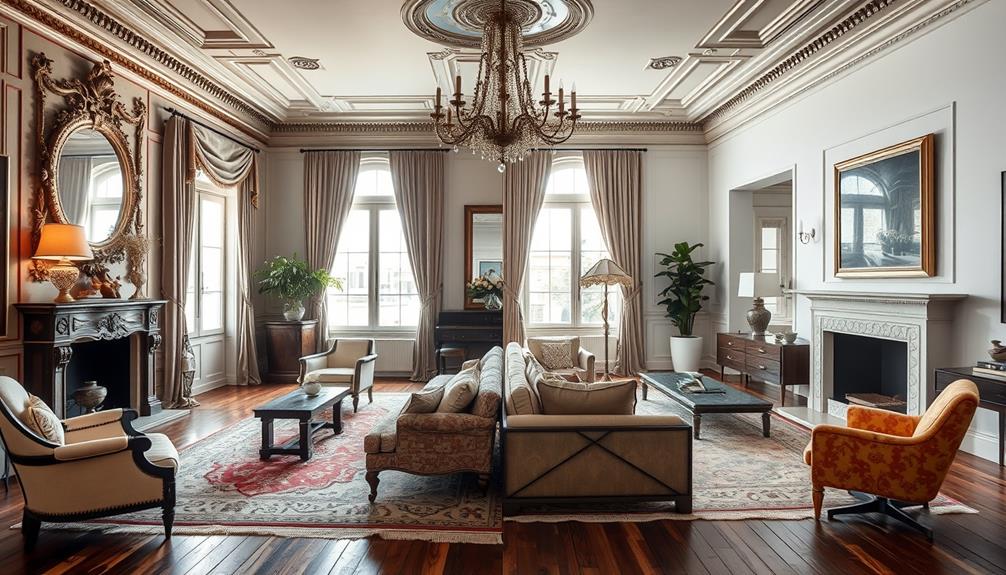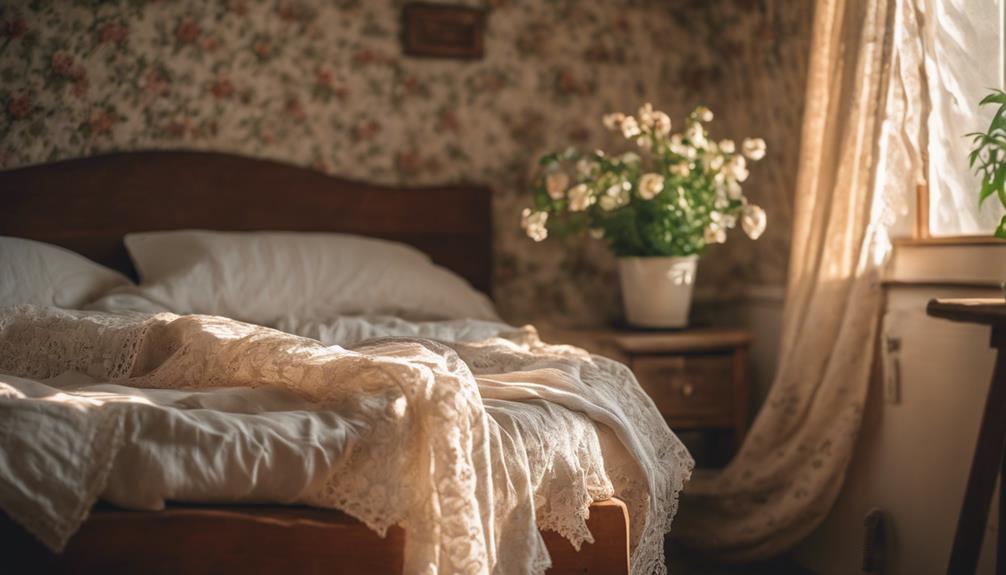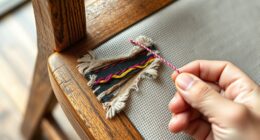Creating a stylish yet calming atmosphere in a chill room involves combining tranquility with decorative elements. Begin by choosing soothing colors such as soft grays or warm earth tones to establish a peaceful ambiance. Use natural materials like wood and soft textiles such as cotton and velvet to add warmth to the space. Enhance comfort by selecting oversized lounge chairs or cozy nook swings. Layer the lighting with gentle pendant lights and whimsical fairy lights to create a welcoming atmosphere. Incorporate personal touches with handcrafted vases or textured wall hangings to add a unique flair to the room. This effortless blend of relaxation and style will make your space more inviting. Continue exploring to find more ideas for your own chill sanctuary!
Key Elements
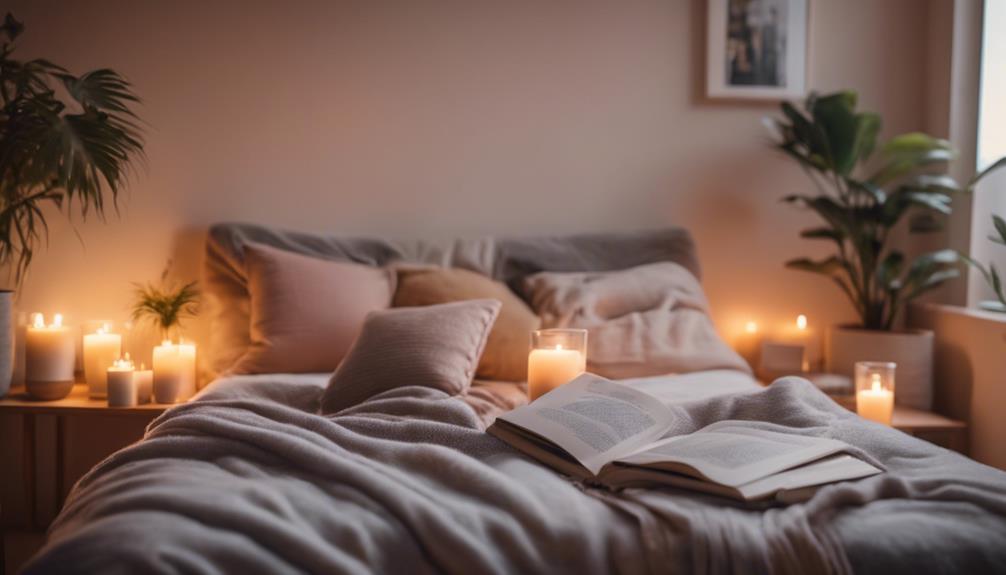
When it comes to creating your chill room, the right color scheme, materials, and textures play an essential role.
You'll want to choose calming colors that set the mood, while soft materials and varied textures provide that cozy vibe.
Let's explore how these key elements can transform your space into a true sanctuary.
Color Scheme
A calming color scheme plays an essential role in creating a relaxing atmosphere for your chill room, often featuring muted neutrals and soft pastels. When choosing your color palette, think about soothing and calm colors like soft grays, beiges, and gentle pinks. These tones help set a tranquil mood, making it easier for you to unwind.
Incorporating warm shades like faded yellow or gold can add depth while maintaining that serene vibe. You might also want to contemplate using earth tones—deep greens and browns can evoke a sense of nature, further enhancing the calming effect.
Monochromatic schemes are another great option, as they involve varying shades of a single color, providing harmony and reducing visual clutter. This approach creates a tranquil space that feels cohesive and inviting.
Don't forget, seasonal decor adjustments can refresh your color palette, allowing you to adapt the ambiance throughout the year while keeping it soothing. By thoughtfully mixing these colors, you'll cultivate a chill room that everyone will love to spend time in.
Materials
Natural materials like wood and stone create a warm, inviting atmosphere in your chill room, enhancing both comfort and relaxation. Incorporating these natural elements fosters a sense of tranquility that's essential for unwinding.
Choose organic textiles like cotton and linen to complement the natural vibe; these materials not only feel great but also enhance the calming effect of your space.
Soft textiles, such as plush rugs, cozy cable knits, and velvety cushions, are key to making your chill room inviting. They add layers of warmth and tactile interest, inviting you to sink in and relax. When selecting these textiles, opt for calming colors that align with your established palette, ensuring they contribute to the soothing environment you're aiming for.
Additionally, don't forget about the importance of greenery. Incorporating plants not only improves air quality but also brings the beauty of nature indoors, further enhancing the serene atmosphere.
Textures
Incorporating a mix of textures not only elevates the visual appeal of your chill room but also enhances the overall comfort, making it a perfect spot for relaxation and socializing.
Start by layering soft textiles like velvet cushions and cable knit throws to create a cozy atmosphere. These tactile elements invite you to sink in and unwind.
Combine plush rugs with smooth wooden furniture to achieve a dynamic look that feels both stylish and inviting.
Don't overlook natural textures—woven baskets and stone accents can connect your indoor space with the calming essence of nature. They add depth while maintaining a serene vibe.
To keep your chill room feeling fresh, consider regularly swapping out or layering different textures. This simple act can rejuvenate the space, ensuring it remains a cozy retreat throughout the seasons.
Whether you're lounging alone or hosting friends, these textured elements create an inviting environment that encourages relaxation and togetherness.
Essential Fixtures and Furniture

When you're setting up your chill room, the right furniture makes all the difference.
Think about incorporating oversized comfy lounge chairs or a hammock chair for ultimate relaxation.
A hanging macrame swing chair can also add a fun twist while inviting you to unwind.
Oversized Comfy Lounge Chair
Why not make an oversized comfy lounge chair the centerpiece of your chill room, offering the perfect spot to relax and unwind? These chairs are typically 36 to 48 inches wide, providing ample space for you and your friends to kick back together. With their plush cushions and soft upholstery—think velvet, microfiber, or cotton—they invite you to lose track of time while lounging.
The ergonomic design of an oversized lounge chair supports your body's natural contours, promoting better posture and reducing strain during long relaxation sessions. You'll find it hard to resist sinking into its comforting embrace.
Plus, their versatility means they can complement any decor style, from modern minimalism to bohemian aesthetics, making them a stylish addition to your relaxing environment.
To enhance the comfort and appeal, consider draping a cozy throw blanket or adding decorative pillows. This not only personalizes your space but also creates an inviting nook perfect for reading or meditation.
An oversized lounge chair is more than just furniture; it's a key fixture that transforms your chill room into a haven of comfort.
Hammock Chair for Relaxation
An inviting hammock chair adds a unique touch to your chill room, offering a cozy spot to sway gently while you read or relax. This stylish fixture combines comfort and aesthetics, making it an ideal addition for creating a serene environment. With options in various materials like cotton and macrame, you can choose one that perfectly fits your decor theme and personal taste.
One of the best features of a hammock chair is its ability to optimize space, especially in smaller rooms. You can hang it from ceilings or sturdy walls, transforming an unused corner into a cozy nook without encroaching on your floor space.
When selecting your hammock chair, pay attention to weight capacity and installation requirements for safety and stability; many designs can support up to 300 pounds.
To enhance your relaxation experience, consider accessorizing your hammock chair with plush cushions and throws. This not only boosts comfort but also turns your chair into a stylish focal point in the room.
Embrace the tranquility a hammock chair brings, and enjoy the perfect blend of style and relaxation in your chill room.
Hanging Macrame Swing Chair
A hanging macrame swing chair instantly elevates your chill room with its stylish design and cozy comfort, inviting you to unwind in a unique seating option.
These swing chairs, often made from durable cotton or polyester rope, can support weights ranging from 200 to 300 pounds, ensuring reliability while you relax. The intricate macrame patterns add a bohemian flair, making it an eye-catching focal point that complements various decor styles.
Installing a hanging macrame swing chair is a breeze—just secure it to a sturdy ceiling hook or beam, allowing you to create a serene space both indoors and outdoors.
For added comfort, consider draping cushions or blankets over the chair, transforming it into the perfect nook for reading, meditation, or simply enjoying a moment of peace.
This cozy addition not only enhances the aesthetic of your chill room but also promotes relaxation, making it an essential fixture for anyone looking to create a stylish and inviting environment.
Lighting Ideas
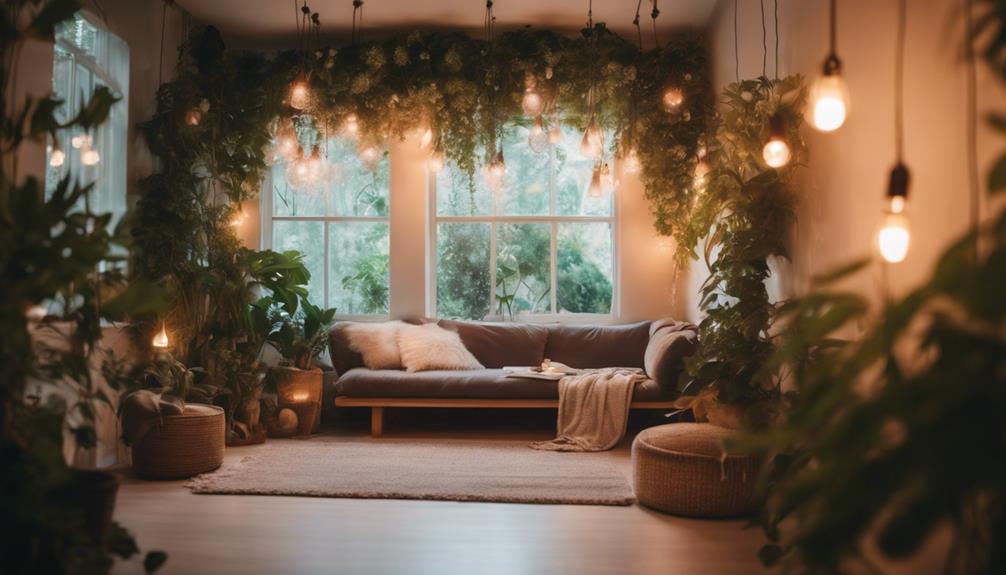
When it comes to lighting your chill room, consider using soft, dimmable pendant lights to set a mellow mood.
Warm fairy light strands can add a whimsical touch, while adjustable floor lamps help you focus light where you need it most.
Don't forget to filter natural light with window treatments that create a welcoming atmosphere during the day.
Soft, Dimmable Pendant Lights
Soft, dimmable pendant lights instantly transform your chill room by allowing you to adjust the brightness for any occasion. Whether you're winding down after a long day or hosting friends, these lights create the perfect ambiance. With soft lighting, you can establish a cozy atmosphere that invites relaxation and conversation.
These pendant lights come in various styles and materials, including glass, metal, and fabric, which means you can easily find options that seamlessly fit your home decor theme. The ability to dim the lights enhances the mood, promoting feelings of comfort and serenity.
Many modern options even integrate smart technology, allowing you to control brightness and color temperature through mobile apps or voice commands. This convenience makes it easy to set the right tone for any moment.
Additionally, consider installing pendant lights at varying heights to create visual interest and depth in your space. This layering of light contributes to that inviting, cozy atmosphere you're aiming for in your chill room.
With soft, dimmable pendant lights, you're just a flick away from achieving the perfect environment for relaxation and enjoyment.
Warm Fairy Light Strands
Warm fairy light strands instantly elevate your chill room's ambiance, creating a cozy and inviting atmosphere. These strands emit warm colors that mimic the soft glow of natural light, helping you relax and unwind after a long day. You can easily customize your lighting scheme by draping or hanging fairy lights in various lengths and styles around your space, making it uniquely yours.
Most fairy light strands feature energy-efficient LED bulbs, which can last up to 25,000 hours, ensuring you have long-lasting illumination without the worry of rising energy costs. Plus, many come with adjustable brightness settings or remote controls, allowing you to tailor the light to suit different moods—whether you're reading, meditating, or simply chilling out.
Incorporating warm fairy lights into your decor not only enhances the visual appeal but also promotes relaxation. The cozy ambiance created by these lights can considerably reduce stress and enhance feelings of comfort, making your chill room a sanctuary.
Adjustable Floor Lamps
Adjustable floor lamps are a fantastic way to enhance your chill room's lighting, providing flexibility to create the perfect atmosphere for any activity. With versatile lighting options, you can easily change the brightness and angle to suit whatever you're doing, whether it's reading a book or unwinding after a long day.
Many adjustable floor lamps come with built-in dimmers, allowing you to set the mood just right. Want to create a cozy vibe? Simply lower the brightness and bask in the warm glow. You can also explore multi-head designs that illuminate larger areas, adding depth and an interesting focal point to your decor.
Energy-efficient LED bulbs are often used in these lamps, giving you bright, long-lasting illumination while keeping electricity usage low. Plus, the sleek designs of adjustable floor lamps can complement any decor theme, from modern to eclectic, enhancing the overall aesthetic of your chill room.
Incorporating these lighting solutions into your space not only elevates the ambiance but also guarantees you have the right light for every moment, making your chill room truly inviting.
Natural Light-Filtering Window Treatments
Transform your chill room with natural light-filtering window treatments that softly diffuse sunlight while preserving your privacy. These treatments, like sheer curtains or light-filtering shades, let natural light illuminate your space, creating a soothing atmosphere that enhances your room's feel.
You can choose from various materials, such as cotton, linen, or polyester blends, allowing you to find the perfect match for your decor style. The soft, diffused light reduces glare, making it easier to relax and unwind. Plus, using these treatments can help you minimize energy costs by reducing the need for artificial lighting during the day.
Many designs come in customizable sizes and colors, so you can tailor them to fit your windows and aesthetic preferences seamlessly. By incorporating light-filtering options into your space, you not only enhance the overall ambiance but also promote a serene and inviting environment.
Decorative Elements
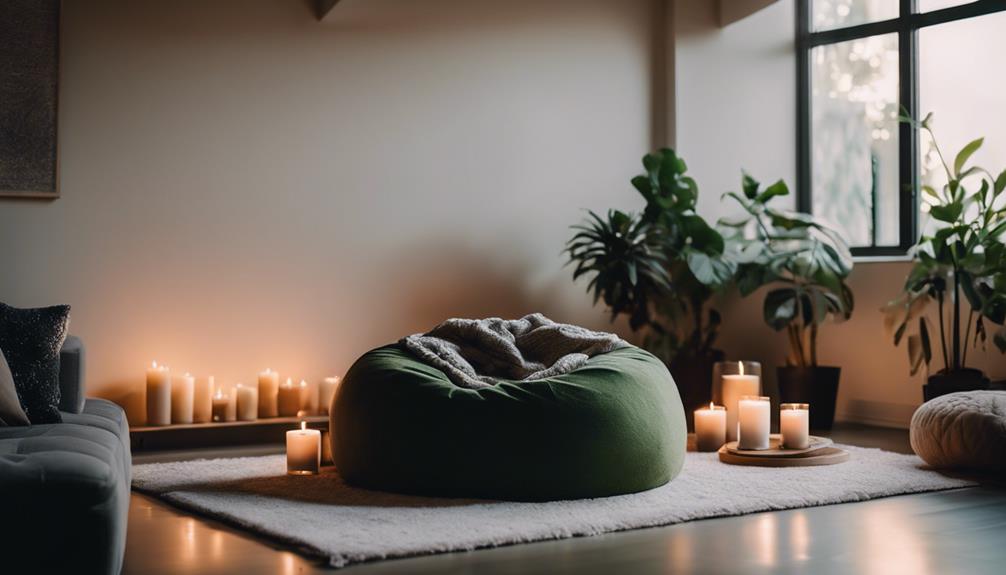
When it comes to decorative elements, you can truly elevate your chill room's vibe with handcrafted ceramic vases and artistic wall hangings.
These unique pieces add a personal touch while enhancing the overall aesthetic.
Don't forget about textured woven wall tapestries; they bring depth and warmth, making your space feel inviting.
Handcrafted Ceramic Vases
Handcrafted ceramic vases bring a unique artistic flair to your space, showcasing your personal style and creativity. These vases come in various shapes and sizes, allowing you to experiment with different decorating ideas that can enhance your environment.
Whether you fill them with fresh flowers or leave them as standalone art pieces, handcrafted ceramic vases can elevate your decor and create a relaxing atmosphere. The use of natural glazes and organic textures gives these vases an earthy aesthetic, promoting tranquility in your room.
They often feature intricate designs that not only draw the eye but also spark conversation among guests. By incorporating these stunning pieces, you're not just enhancing your space; you're also supporting local artisans and sustainable practices.
Place a few handcrafted ceramic vases on your shelves, tables, or windowsills to create focal points throughout your home. Mix and match different sizes and colors to add depth and interest.
When you embrace the beauty of handcrafted ceramic vases, you'll transform your space into a stylish retreat that reflects who you are while fostering a sense of calm and relaxation.
Artistic Wall Hanging
Artistic wall hangings add a unique touch to your decor, enhancing the ambiance while reflecting your personal style. By incorporating artistic wall hangings, you can create a cozy and inviting space that inspires relaxation and creativity. Choose pieces made from natural materials like macramé or woven textiles to connect your interiors with the calmness of nature.
Using a variety of textures and colors in your wall hangings can create a layered look, adding depth and visual interest to your room. Consider displaying artwork that resonates with your personal experiences; this fosters a sense of belonging and comfort in your environment. Each piece tells a story, making your space feel more personal.
Don't forget to refresh your wall decor periodically. Rotating your artistic wall hangings seasonally keeps your space dynamic and engaging. You'll find that a simple change in wall art can greatly impact your room's overall vibe.
Embrace the creative process, and let your walls showcase your personality while enhancing the tranquility of your chill room decor. With the right artistic wall hangings, you can effortlessly create a haven that everyone will love.
Textured Woven Wall Tapestry
Textured woven wall tapestries serve as striking decorative elements that enhance your chill room's warmth and depth. These unique pieces are crafted from natural materials like cotton, wool, or jute, promoting a cozy and inviting atmosphere. Their intricate patterns and designs not only add character but also showcase artisanal craftsmanship, making them a worthy focal point in your space.
Incorporating textured woven wall tapestries can greatly contribute to the overall aesthetic, drawing attention and creating visual interest without overwhelming your decor. They act as natural sound absorbers, helping to reduce noise levels and contributing to a serene environment—ideal for relaxation and unwinding.
Moreover, these tapestries are incredibly versatile, easily complementing various styles, from bohemian and rustic to modern and minimalist. By selecting a tapestry that resonates with your personal style, you can transform your chill room into a haven of comfort and creativity.
Flooring
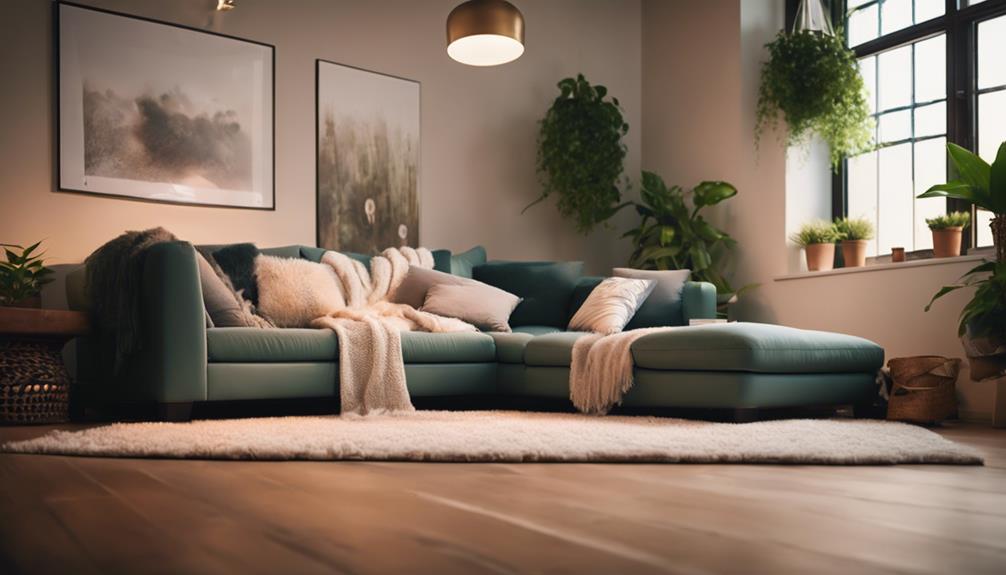
When it comes to flooring for your chill room, you've got some great eco-friendly options to contemplate.
Bamboo flooring brings a sustainable touch, while cork flooring helps absorb sound, creating a peaceful atmosphere.
If you're after a rustic vibe, reclaimed wood can add unique charm and character to your space.
Bamboo Flooring for Eco-Friendliness
Bamboo flooring offers an eco-friendly alternative to traditional hardwood, as it grows rapidly and can be harvested in just 3 to 5 years. This makes bamboo a sustainable choice that helps reduce deforestation and promotes a healthier planet. Unlike hardwoods, which can take decades to mature, bamboo's quick growth allows you to enjoy a beautiful floor without compromising the environment.
Not only is bamboo flooring a sustainable choice, but it's also incredibly durable. In fact, it's often harder than oak, making it suitable for high-traffic areas in both homes and businesses. You'll find a variety of styles and colors available, so you can easily match it with your decor while maintaining a natural aesthetic.
Additionally, bamboo flooring is low in VOC emissions, contributing to improved indoor air quality, which is essential for creating a relaxing environment. Caring for it is simple too; regular sweeping and occasional damp mopping will keep it looking beautiful for years to come. By choosing bamboo flooring, you're not only enhancing your space but also making a positive impact on the environment.
Cork Flooring for Sound Absorption
Cork flooring considerably enhances your chill room by absorbing sound, reducing noise pollution by up to 50% compared to harder surfaces. Its unique cellular structure contains millions of air-filled chambers that effectively dampen sound waves, creating a more tranquil environment. You'll appreciate how this feature contributes to a peaceful ambiance, allowing you to unwind without distractions.
Not only does cork flooring provide excellent sound absorption, but it's also comfortable underfoot. The softer surface minimizes the impact of footsteps, adding to the serene experience of your space.
Plus, cork is an eco-friendly material sourced from the bark of cork oak trees, making it a sustainable choice that aligns with your commitment to a healthy environment.
Maintaining cork flooring is a breeze, as it's easy to clean and resistant to mold and mildew. This resilience guarantees that the peaceful ambiance of your chill room remains intact over time.
Reclaimed Wood for Rustic Charm
In addition to the sound absorption benefits of cork flooring, incorporating reclaimed wood can bring a rustic charm that enhances the overall aesthetic of your chill room. Each plank of reclaimed wood has a unique history, giving your space a personalized touch that new wood simply can't match. Sourced from old barns, factories, and even wine barrels, reclaimed wood showcases beautiful patinas and natural imperfections that add character.
Choosing reclaimed wood flooring not only elevates your decor but also supports sustainable practices. By repurposing materials that would otherwise contribute to waste, you're actively reducing your environmental impact. Plus, reclaimed wood is often free from harmful chemicals and finishes, improving indoor air quality for a healthier living space.
The rustic charm of reclaimed wood, combined with its eco-friendly credentials, makes it a perfect choice for your chill room. You'll enjoy a cozy atmosphere while also making a positive contribution to the planet.
What Are Some Key Elements in Creating a Chill Room Decor for a Relaxing and Stylish Environment?
When looking to create a stylish chill room, there are a few key elements to consider. First, choosing a calming color palette and comfortable seating is essential. Adding soft lighting, cozy textures, and incorporating elements of nature can also help to create a relaxing and inviting atmosphere.
How Can I Create a Relaxing and Aesthetic Bedroom Environment?
Transform your bedroom into a serene oasis with these aesthetic bedroom revamp ideas. Start by decluttering and organizing your space to create a calming atmosphere. Incorporate soft, neutral colors, cozy textiles, and natural elements to bring a sense of tranquility. Consider adding plants, soothing lighting, and personal touches to make it truly your own.
Conclusion
By incorporating these key elements into your chill room decor, you'll create a relaxing and stylish space that everyone will love.
Focus on essential fixtures and furniture that promote comfort.
Choose lighting that sets the mood, and add decorative elements that reflect your personality.
Don't forget about the flooring, as it ties everything together.
With a little creativity and thoughtfulness, your chill room will become a go-to spot for relaxation and enjoyment.
Happy decorating!
